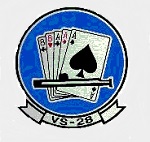Hobby Master HA4902 US Navy Lockheed S-3A Viking Anti-Submarine Aircraft - 159741, VS-28 "Gamblers", USS Forrestal (CV-59), 1986 (1:72 Scale)
"The S-3 was a unique program. We went from first contract to first contact over a submarine in just three years."
- Lockheed Executive Vice President Tom Burbage, who flew the Viking as a Navy test pilot and later ran the S-3 program for the company
 The Navy began what became the S-3 Viking program in 1964 to replace the piston-powered S-2 Tracker. Known originally as VSX - for "carrier-based antisubmarine warfare aircraft-X" - a formal request for proposal was issued in April 1968. A joint General Dynamics-Grumman team and the then-Lockheed Aircraft Corp. were chosen from among the competitors to refine their proposals.
The Navy began what became the S-3 Viking program in 1964 to replace the piston-powered S-2 Tracker. Known originally as VSX - for "carrier-based antisubmarine warfare aircraft-X" - a formal request for proposal was issued in April 1968. A joint General Dynamics-Grumman team and the then-Lockheed Aircraft Corp. were chosen from among the competitors to refine their proposals.
Although Lockheed had four decades of land-based antisubmarine warfare experience dating back to the World War II-era Hudson, the company had only built one carrier-based aircraft to that point, the T2V-1 SeaStar trainer. To build a strong Navy-oriented team, Lockheed first brought on LTV Aerospace, formerly Vought, with its long history in carrier aviation, as a partner. Then the Federal Systems Division of Sperry Rand was added to develop the aircraft's computerized acoustic detection system, a first for an airborne antisubmarine warfare platform.
The Lockheed team was declared the winner of the VSX competition on August 4th, 1969. One of several speakers at the 2009 retirement ceremony was current Lockheed Martin F-35 Executive Vice President Tom Burbage, who flew the Viking as a Navy test pilot and later ran the S-3 program for the company. He noted that "the S-3 was a unique program. We went from first contract to first contact over a submarine in just three years."
Pictured here is a 1:72 scale replica of a US Navy Lockheed S-3A Viking anti-submarine aircraft that was attached to VS-28 "Gamblers", then embarked upon the USS Forrestal (CV-59) during 1986.
Sold Out!
Dimensions:
Wingspan: 9-inches
Length: 11-1/2-inches
Release Date: June 2016
 Historical Account: "Gamblers" - VS-28 began 1986 at sea embarked on USS Forrestal (CV-59) for ISE (Independent Steaming Exercises). Returning to NAS Cecil Field, the Gamblers commenced a series of dedicated ASW exercises with submarines from COMSUBRON Sixteen. Aimed at basic tactical development these MOU (Memorandum of Understanding), operations established a new baseline for VS-28 ASW expertise. The MOU ASW operations continued into March when VS-28 embarked in (CV-59) for CV Phase I/IA training. Sandwiched between lSE, CQ (Carrier Qualification) and during CV-59 REFTRA (Refresher Training) the Gamblers set the standard for S-3A, aerial mining. Delivering more than 30 airborne anti-shipping mines in February, VS-28 scored a 100% COMINEWARCOM graded weapon qualification rate. Most important, VS-28 briefed and lead the 1986 CVW-6 MRCI (Mine Readiness Certification Inspection) TAV. During the TAV VS-28 became the first ever S-3A squadron to deploy an operational MK-60 "CAPTOR" minefield using radar offset mining and scored "E's" doing it.
Historical Account: "Gamblers" - VS-28 began 1986 at sea embarked on USS Forrestal (CV-59) for ISE (Independent Steaming Exercises). Returning to NAS Cecil Field, the Gamblers commenced a series of dedicated ASW exercises with submarines from COMSUBRON Sixteen. Aimed at basic tactical development these MOU (Memorandum of Understanding), operations established a new baseline for VS-28 ASW expertise. The MOU ASW operations continued into March when VS-28 embarked in (CV-59) for CV Phase I/IA training. Sandwiched between lSE, CQ (Carrier Qualification) and during CV-59 REFTRA (Refresher Training) the Gamblers set the standard for S-3A, aerial mining. Delivering more than 30 airborne anti-shipping mines in February, VS-28 scored a 100% COMINEWARCOM graded weapon qualification rate. Most important, VS-28 briefed and lead the 1986 CVW-6 MRCI (Mine Readiness Certification Inspection) TAV. During the TAV VS-28 became the first ever S-3A squadron to deploy an operational MK-60 "CAPTOR" minefield using radar offset mining and scored "E's" doing it.
March and April were marked by intensive at-sea operations on CV-59. During two short in-port periods, the Gamblers won the coveted VS Wing One Crew of the Quarter competition besting the best of VS Wing One and completed a zero discrepancy ADMAT (Administrative/Material) inspection. At sea, the CVW-6 S-3A flight element in the 1986 M RCI posted flawless results: all flight crews earned qualifying scores. Fleetex 2-86 tested the training of VS-28, the Gamblers were up to the task. Flying over 721 hours between April 9th and 21st, the Gamblers attacked every exercise submarine before they could attack the Carrier Battle Group.
MED 86 started in June. The VS-28/CVW-6/CV-59 team had been tested and was ready to meet the challenge. During the Atlantic transit, the Gamblers aided in the validation of the Harvard Oceanographic Prediction Model and skillfully plyed their honed ASW skills against various non-us submarines.









